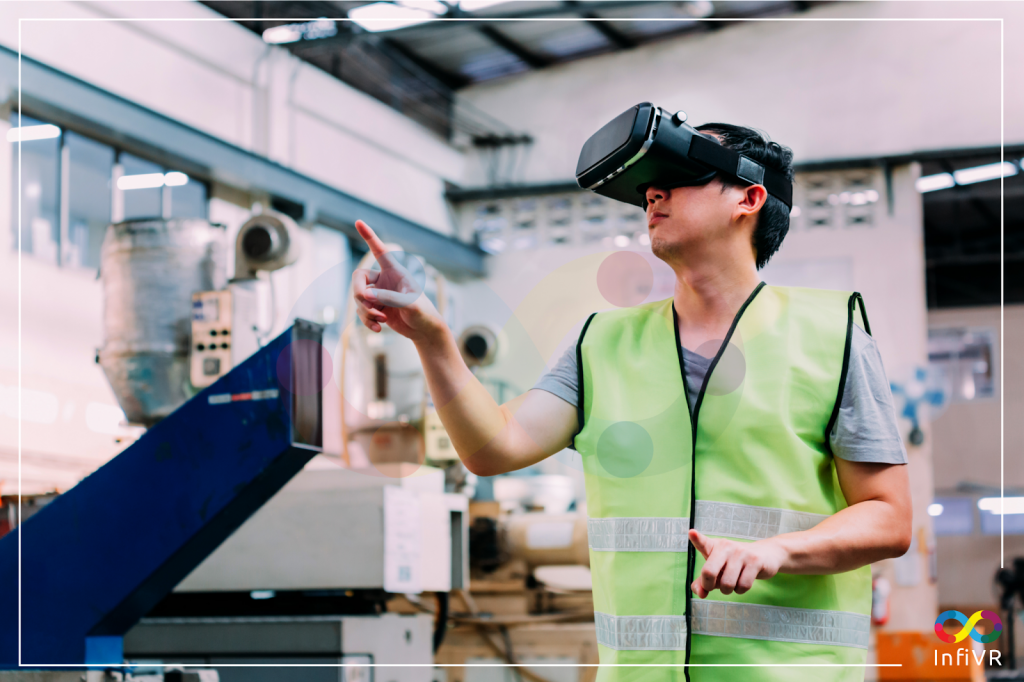Let’s now explore the types of VR training applications and use cases.
Experiential Training
Additionally, Experiential Learning, a highly effective teaching method, places emphasis on hands-on experiences and real-world applications. The overarching goal is to cultivate a dynamic learning environment that enables students to forge connections between theoretical knowledge acquired in the classroom and its practical application in real-life situations.
Revolutionizing Training: The Ascendancy of Virtual Reality (VR) Technology
Increasingly, Virtual Reality (VR) technology is emerging as a powerful tool to deliver experiential training. By immersing learners in a customized virtual environment, VR harnesses the concepts of presence and plausibility. This immersive experience not only enhances engagement but also fosters true behavioral change, marking a significant evolution in the traditional approach to education.

VR-Based Experiential Training
Experiential training using VR offers numerous benefits over traditional training methods. For one, it provides a safe and controlled environment for learners to practice and develop skills without the risk of harm or damage. Additionally, the highly engaging and interactive experience of VR helps increase motivation and retention of information.
Versatile Applications of VR in Employee Training
Companies can use VR-based experiential training to train their employees in a variety of skills, including customer service, sales and marketing, safety and emergency response, team building, and technical skills. Whether it’s handling difficult customers, improving teamwork, or operating machinery, VR provides a flexible and scalable training solution that can help employees develop the skills they need to excel in their job roles.
Outdoor-Based Experiential Training for Managers
Outdoor-based experiential training is another popular method for training managers. These programs are designed to be engaging and motivating, taking place in fresh and stimulating settings that help reduce conflicts that can occur in the workplace. By directly involving managers in the learning process, they can better understand and apply the concepts they have learned.
The use of VR in experiential training provides several advantages over traditional training methods:
- VR allows learners to practice and develop skills in a safe and controlled environment without the risk of harm or damage.
- VR provides a highly engaging and interactive experience, which can help to increase motivation and retention of information.
- VR can be used to create real-life simulations, providing a more accurate representation of the skills required for a job or task.
Overall, VR-based experiential training provides companies with a flexible and scalable training solution, allowing employees to develop skills in a safe and engaging environment. This can help to increase employee satisfaction and retention, as well as improve job performance and overall business outcomes.
Explore more about Virtual Reality Training with InfiVR:
At InfiVR, we revolutionize industrial training by seamlessly integrating virtual reality simulation and immersive 3D gamification experiences. Moreover, As proud partners to numerous Fortune 500 companies, we are committed to actualizing your next-generation training visions. Let’s collaborate to elevate your business through cutting-edge training solutions! For more information, feel free to reach out to our consultation experts at hello@InfiVR.com.
Want to know more:
- What is Virtual Reality?
- What is Virtual Reality Training?
- What is VR Simulation?
- Advantages of Virtual Reality Training?
- Applications of Virtual Reality Training.
- Virtual Reality Maintenance Training.
- Virtual Reality Inspection Training.
- Virtual Reality Operational Training.
- Virtual Reality Assembly Training
- Virtual Reality Support & Servicing Training
- Various types of Virtual Reality Training Mediums.
- Virtual Reality based Experiential Training
- Operational Virtual Reality Training
- Virtual Reality based Behavioral Training
- Different Types of Environments in VR Training – 3D Virtual Environment.
- Mixed Reality Virtual Environment.
- Spatial Virtual Environment.
- 360* Photography-based Virtual Environment.
- VR Training in the Aviation Industry.
- VR Training in the Aerospace Industry.
- VR Training in the Defence Industry.
- VR Training in the Oil & Gas Industry.
- VRTraining in the Warehouse Industry.
- VR Training in the Manufacturing Industry.
- Hardware Selections for Virtual Reality Training
- How to adopt virtual reality training for your company?
- How to look for a suitable partner for Virtual Reality Training development?
- How to develop Virtual Reality Training POC?
- How to assess the effectiveness and advantages of Virtual Reality Training POC implemented?
- How to develop Virtual Reality Training for full-scale implementation?
- Survey forms for feedback capture on VRT
- How to successfully draft a VR training RFP?